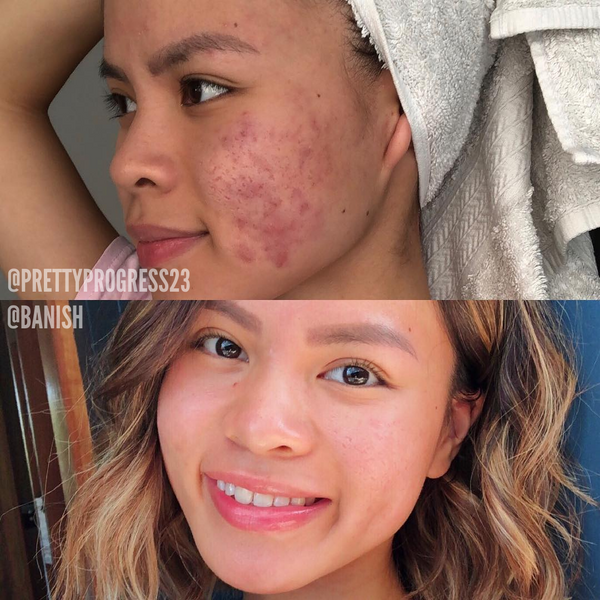Views: 0
Everyone has probably dealt with acne at one point in their lives. Acne is stubborn and tough to get rid of, and you may feel victorious after you’ve finally managed to get your acne under control.
However, the side effect of acne that not many people talk about are the scars that acne leaves behind. But don’t worry, there are many different ways to treat acne scars. If you want to treat your acne scars, here are treatments that work!
What Are Acne Scars?
Acne scars can appear due to the damage in collagen caused by acne. Acne tends to leave behind texture changes, and dark marks. Depending on the type of scar, it may remain there for several months, or even years.
Treating and getting rid of acne scars is not that easy, but don’t fret as you’re not alone in that journey.
Types Of Acne Scars
Dealing with acne is only half the battle as an inflamed blemish will stretch our collagen fibers over time and which can lead to long term damage on our skin’s surface. This damage may leave textured acne scars, or dark marks.

The common types of acne scars are
- Rolling scars
- Ice pick scars
- Boxcar scars
- Hyperpigmentation
Out of the above acne scar types, hyperpigmentation is the one easiest to reduce and is temporary so not a true scar, while the other scar types are usually permanent if they are not treated.
Hyperpigmention are the dark spots and discoloration which can range from shades of black, brown, purple, and red and the easiest to treat.
Boxcar scars are shallow with a strong straight and defined edge. Rolling scars are depressed scars with less of a defined edge or ridge, and ice pick scars are deep and narrow which are more difficult to treat.
If you have keloid scars, it’s best to see a skincare professional to help treat keloids as they are tricky to treat.
Acne Marks Versus Acne Scars
What’s the difference between acne marks and acne scars? Acne marks refer to the discoloration or dark spots from post inflammatory hyperpigmentation. Hyperpigmentation can fade on their own although it can take several months and years, even.
Whereas acne scars are a result of texture change that can be raised or indented that are permanent without treatment.
Acne scars can leave a serious impact on one’s self-confidence. It’s hard for some to look beyond the discoloration and uneven texture after having acne scars, but no worries, there are several methods for getting rid of acne scars.
Top ways to get rid of acne scars
Microneedling
Type of scar: rolling scars, boxcar, ice pick scars, and hyperpigmentation.
Microneedling is an acne scar treatment that uses very fine needles to prick the skin.
Its purpose is to break down the scar tissue and promote the generation of new collagen, which is the foundation of skin to push the old damaged skin out and fill in acne scars over time.
Microneedling shouldn’t be done over active acne. The great thing about microneedling is that it less invasive compared to laser acne scars treatments and the results are permanent.
Microneedling can get rid of acne scars fast and is great for indented or pitted acne scars as well as hyperpigmentation. Microneedling promotes the absorption of topical products so be careful of what products you apply onto the skin after microneedling.
For an at-home microneedling treatment, you use smaller needle sizes found on the Banisher 2.0 that can be done once a week or once every other week and they provide a natural Vitamin C Serum designed to be used with it for acne scars.
Consult your dermatologist for guidance or go in for an in-office treatment if you have very deep ice pick scars that may need more aggressive treatment.

Retinoid
Type of scars: hyperpigmentation, minor texture
Retinoids such as retinol, adapalene, or Vitamin A products have been considered a go-to ingredient for both acne scars and acne. Retinols promote cell turnover or shedding of dead skin cells and encourage the development of collagen.
Take note that retinol is not as strong as prescription-strength retinoids so retinol or derivatives of it are what you find in drugstore skincare products.
You may apply a retinoid once daily for several weeks for you to improve acne scarring. A word of warning is that retinoids and its derivatives may cause purging for the first couple of weeks and they can cause irritation to the skin so best to start off slow.
CHEMICAL PEELS
Type of scars: Ice pick, boxcar
Your dermatologist may recommend deeper chemical peels that contain acids with higher concentrations. These peels work in the same way as the kinds you use at home to dissolve the uppermost layers of skin, only that they work on a deeper level.
Deeper peels such as TCA peels should be done by a professional and can improve moderate to severe acne scars with the proper aftercare and with the supervision of a professional.
Be careful not to try these deep peels by yourself, as not all skin types are suitable for this acne scar treatment and it can run the risk of causing more scarring.
You can use skincare products that are made with more gentle acids or lower concentration acids for light acne scarring. Look for ingredients like glycolic acid, lactic acid, mandelic acid, and salicylic acid.
Radiofrequency Microneedling or PRP Microneedling
Type of scars:Ice-Pick, Rolling scars, Boxcar Scars
PRP microneedling is a procedure in the office with a device that injects your own plasma into your skin for the healing properties and collagen production to heal acne scars.
RF microneedling combines radiofrequency with LED which creates heat and microneedles together. The device is handled by a professional. The needles and heat will both break down scar tissue, and stimulate collagen to fill in scars.
In office microneedling treatment prices may vary, but downtime may take 4-5 days.
LASER TREATMENTS
Type of scars: ice pick, boxcar, rolling, dark spots
Most laser treatments work by sending pulses of light that create heat energy to damage the top layer of skin. These lasers can induce the wound healing response, so that new tissue can form in its place.
Certain types of ablative laser such as co2 laser may not be suitable for scarring for darker skin tones as they could increase the risk of hyperpigmentation.
Depending on the type of laser, they can treat mild to severe acne scarring. It requires a consultation with a dermatologist before you can undergo laser resurfacing and a few sessions may be needed to see desired results.
Non ablative laser treatments such as fraxel dual are less aggressive and may be suitable for skin types that are more prone to scarring or pigmentation issues.
There are different formats of laser therapies for acne scars so the recovery times may differ.
AHA or Glycolic Acid
Type of scars: hyperpigmentation, discoloration
Glycolic acid is an AHA which stands for alpha hydroxy acid. This AHA is one of the most effective AHAs and a very popular ingredient for fading acne scars. Glycolic Acid can also get rid of hyperpigmentation, acne, and discoloration.
Glycolic acidis a naturally occurring substance that offers many benefits to the skin such as rejuvenation and exfoliation. Glycolic acid can be found in chemical peels and it is an ingredient in consumer skincare products without causing too much irritation with the right PH, concentration, and frequency of use. This ingredient is also included in the BANISH Pumpkin Enzyme Masque.
Vitamin C
Type of scars: hyperpigmentation and dark spots, minor texture.
As we say, Vitamin C is one good source when it comes to getting rid of acne scars for its wound healing, collagen production, and brightening properties.
Vitamin C is great for treating acne scars as it is responsible for our skin’s health, elasticity, collagen synthesis, and it prevents excess melanin production.
Vitamin C acts as an antioxidant to prevent acne scars, and Vitamin Capplied topically in the form of L-Ascorbic acid has been shown to reduce dark marks as well as stimulate collagen production to heal acne scars.
Apply a Vitamin C Serum daily and try not to apply it at the same time as a retinoid product for optimal effectiveness.
This is also one of the ingredients included in the Banish Vitamin C Serum, and Vitamin C Creme.
Niacinamide
Type of scars: Dark spots and hyperpigmentation.
Also known as nicotinamide, niacinamide is a form of Vitamin B-3 which is an essential nutrient when it comes to treating acne scars. Niacinamide works by lightening dark marks, reducing inflammation, and improving tissue regeneration.
Niacinamide has several benefits on our skin – it builds keratin which keeps our skin firm and healthy, acts as a lipid barrier, reduces inflammation that may help ease the redness from eczema, acne, and other inflammatory conditions, keeps our skin moisturized, and regulates oil production.
While niacinamide may help with dark marks, it may not help with textured or deep acne scars.
Niacinimide is commonly found in many skincare products, even if the products are not directly targeted for acne scarring.
Vitamin E
Type of scars:dark spots and hyperpigmentation
Vitamin E has some mixed results that show it can help helps heal hyperpigmentation by strengthening the skin’s protective barrier and improving the overall formation of healthy skin cells and tissues. It also works to combat any free radicals which can possibly damage your skin and speeds up wound healing. Studies show that Vitamin E works best with combined together with Vitamin C
Natural Remedies For Acne Scars
If you want to stick with home remedies for your own reasons, natural home remedies to get rid of acne scars could give mixed results and aren’t able to show results for deep and pitted acne scars.
If your acne scars are limited to mild hyperpigmentation or discoloration, these home remedies could work for you.
ALOE VERA
Aloe is one of the best household products anyone can use to treat their hyperpigmentation.
Aloe contains aloesin which has some evidence of destroying melanated cells, and in preventing hyperpigmentation caused by UV radiation.
Aloe improves wound healing by strengthening collagen structure. Aloe Vera has been a popular plant remedy or solution for many skin problems such as acne, so if you are still dealing with acne, aloe vera is fine to use.
To Use: Purchase Aloe vera gel and apply onto skin daily.
APPLE CIDER VINEGAR
This fermented vinegar has a lot of useful functions, including fading your acne scars by naturally exfoliating and shedding away dead skin cells.
It contains Vitamins A, B2, B6, C, and E along with the natural lactic and malic acids which are responsible for gently exfoliating the skin for a more even-toned complexion. Dilute it with water so it doesn’t cause too much stinging and to help lower the acidity.
It takes a lot of patience and consistency to see positive results, no matter what products or options you choose in treating acne scars. Don’t be afraid to try different options should the first one fail. You may even need a combination of treatments if your acne scars are on the moderate to severe side.
Keep the healing up with some emotional treatment as well. Acne does not only leave with deep physical scarring but emotional scarring too.
You’re still beautiful with or without acne.












